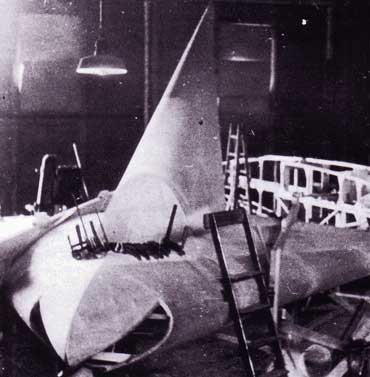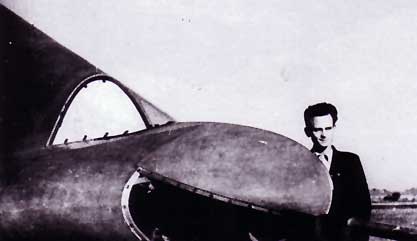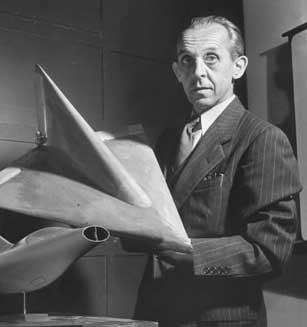


Lippisch DM-1 Glider Testbed for the Supersonic Ram-Jet WWII Fighter P13a

The last desperate attempts by the Luftwaffe to stop the Allied bomber streams were exemplified by the demand: fighters, fighters, fighters - quick and simple to build, cheap and from easily accessible materials, small dimensions, superior speed compared to enemy escort fighters and firepower. Nearly all aircraft manufacturers and designers in the Third Reich put designs to paper along these lines.
Even Dr. Lippisch's ideas during the last year of the war fit into this concept. Of his numerous variants, the Lippisch 13a was actually given serious consideration. This model, the Lippisch DM-1 was the test-bed for the very advanced -but never to be built-supersonic P13a Fighter.
From Bill Pace:
1. Like with the Pa-13a, I first connected the
upper seam, starting at the
nose and working toward the back. It has a slight convex
shape.
2. Then I attached the cockpit/fin business. Leaving the
trailing edge
open, I bent the tabs over in their slots and glued them
down. Then I
glued the other tabs down beginning with the front. I sealed
the trailing edge
just before gluing the after-most tabs down.
3. Then I glued the underside together, starting from the
front. The nose
has a pretty good shape to it, considering the compound
curvature.
4. Next I glued the trailing edges of the wings together.
One of the
trailing edge tabs says don't score but it should say do
score. (fixed)
5. I sandwiched thick, stiff cardboard in the landing gear
struts,
darkened the wheel wells and inside the doors, and cut slots
in the wings to insert
the struts. They were way too long so I cut them off shorter
to look like the 3-view.(fixed)
The LG's are a little wobbly.
6. The tread strips for the tires were about 1/16"
or 3/32" too
long to match the circumference of the wheels so I had to
correct that. I always
check to see if treads match their tires. (fixed)
7. I used a round toothpick, painted gray, for the probe.
8. I used the stand, showing the plane tilted a little toward
the earth as
if hurtling to its destruction. I think Leutnant Schnitzelgruber
needed
to flatten out his glide path a little. The stand (the way
I used it) seemed
to have its label upside down, but maybe I just mounted
the plane
backwards. (fixed)
The whole model looks fine to me and makes a nice companion
piece to the
coal-burner. They make me want to build a Siebel 204a to
carry them
skyward. The only problem is with the landing gear. They
could have a
more secure way of attaching them to the wings. And they
need more stiffness
where the wheels are attached. (we recommend building with
#110 cardstock for
wheel attachment and hot melt glue for attaching the LG
to the wings. Truth be
known, we think the model looks best with NO landing gear
at all:)
Lippisch DM-1 Glider
 In 1937 Doctor Alexander Lippisch assumed the
leadership of a design team developing the RLM's Projekt X, which
was eventually to become the Me 163 rocket-powered interceptor.
Five years later he left the project, just as the first Komet
production prototypes were being completed, to lead another research
team consisting of students of aircraft construction from Darmstadt
and Munich universities.
In 1937 Doctor Alexander Lippisch assumed the
leadership of a design team developing the RLM's Projekt X, which
was eventually to become the Me 163 rocket-powered interceptor.
Five years later he left the project, just as the first Komet
production prototypes were being completed, to lead another research
team consisting of students of aircraft construction from Darmstadt
and Munich universities.
Working with the help of the DFS on a program intended to lead to the development of a fast interceptor, Lippisch and the students produced a series of revolutionary aircraft, designated with a DM prefix in recognition of the two universities. The DM-1 Experimental Glider prototype of the P-13a Supersonic Fighter was found in an incomplete state at the end of the war by the Americans.
Construction work had started on the DM-1 flying testbed in November 1944. A pure delta with 60 swept leading edges, it was to be used initially as a glider to investigate flight characteristics of this unique configuration. Fin and rudder shape mirrored that of the wings, and the pilot was accommodated in a cockpit at the base of the fin.
| It was originally intended to carry the DM-1 on the back of a Siebel Si 204 to a height of 25,900 ft, from which it would dive to an anticipated speed of 348 mph. At a later stage the DM- 1 was to be flown at a speed of 497 mph under the power of a rocket motor. At the other end of the speed range, the aerodynamic characteristics of this little single-seat aircraft were such that a landing speed of only 44 mph was expected. |  The Si 204 with the Lippisch DM-1 Glider |

Diagram of the Mistal style planned DM-1 launching from a Siebel 204A |
|
It was the end of the war that prevented further development beyond this un powered DM-1 test glider. The Americans shipped the prototype back to the USA for completion and flight testing, and the resulting data were incorporated into the design of the many US delta-wing aircraft. After the war, Lippisch, working with American aircraft designer Convair, developed and tested the XF-92 based on his designs, leading to the eventual adoption of the F-102 Delta Dagger and its successor, the F-106 Delta Dart.
 |
 Shop photo of the Lippisch DM-1 Glider rudder |
 |
 Front views of the Lippisch DM-1 under construction |
 This front view offers a sense of 'cute' to this little aircraft |
 Photo of Dr. Lippisch's able assistant, Wolfgang Heinemann standing next to the DM-1 |
 Your cardmodel of the Lippisch DM-1 will fly great when launched using a large rubber band !! |
 Two variations of the DM-1 proposed by Dr Lippisch |
Around Christmas 1944, a full-scale piloted prototype, known as
the DM 1 (DM - Darmstadt München Entwurf 1, the first project
and the location of its development), was under construction at
Prien on Lake Chiemsee in Bavaria. For actual flight testing, the
DM 1 was to be mounted on top of a Siebel 204A carrier aircraft.
When Allied tanks appeared on the air field at Prien on May 3, 1945,
the aircraft was nearly complete. Ninety days after the end of the war in Europe, August 6, 1945, the Americans
proposed finishing the project and test-flying the prototype atop
a Douglas DC-3. However, by the time the DM 1 was completed a few
weeks later, the group was ordered to transfer the experimental
aircraft to the United States for proper evaluation. In January
1950, the DM 1 became the property of the National
Air and Space Museum (NASM) and was transferred to their storage
facility outside Washington, DC.
days after the end of the war in Europe, August 6, 1945, the Americans
proposed finishing the project and test-flying the prototype atop
a Douglas DC-3. However, by the time the DM 1 was completed a few
weeks later, the group was ordered to transfer the experimental
aircraft to the United States for proper evaluation. In January
1950, the DM 1 became the property of the National
Air and Space Museum (NASM) and was transferred to their storage
facility outside Washington, DC.
"Triebflugel" project of Focke-Wulf. (image right)..This was a separate helicopter-like vertical takeoff aircraft with everything else operating as with a flying wing. The ramjet operated by itself only after a certain speed had been reached. This process involved ram air entering in through an opening in the front, being mixed with fuel, compressed, ignited and forced out the back.
|
|
 Photos of a plastic model of the Lippisch DM-1 Glider |
 |
At
the end of the war not even the prototype DM-1 test glider
had not been finished when it was captured by US forces. It
was ordered to be completed by Lippisch's team and was then
shipped to the USA where it was test-flown. Reportedly the
results were very positive and lessons learned were incorporated
into NASA's research aircraft of the 1950s and on. The Americans
shipped the prototype back to the USA for completion and flight
testing, and the resulting data were incorporated into the
design of the many US delta-wing aircraft which appeared in
subsequent years.
|
|
BIBLIOGRAPHY:
Alexander Lippisch was born Nov. 2, 1894 into a highly cultured
family. His father was a creative artist and Alexander apparently
took after his father in art as well as music. During his early
youth he became interested in flying after observing the flights
of the Wright bothers in 1909. He was drafted by the by the military
in early 1915 and in the fall became ill with pneumonia. After recovering
he got a job in aerial surveying with the army. In 1918 he was discharged
from the army and got a job in the Zeppelin factory where he was
appointed to work under Mr. Claude Dornier. Here he studied the
new science of aerodynamics and worked there until the armistices
was signed in 1918.
was discharged
from the army and got a job in the Zeppelin factory where he was
appointed to work under Mr. Claude Dornier. Here he studied the
new science of aerodynamics and worked there until the armistices
was signed in 1918.
After the war, Lippisch was out of a job and returned home until
1921 when he worked on sailplanes. During the 1920's he was involved
in the design and construction of many sailplanes and gliders. Included
were many unusual designs and swept wing configurations. These designs
led to the tailless aircraft and the delta wing configuration which
Lippisch felt was the configuration of the future.
Although he never went to college he learned engineering from his
work at the Zeppelin factory under the Claude Dornier. He also conferred
with Professor Ludwig Prandtl one of the foremost aerodynamics of
his time. Based on the work with the delta wing and tailless airplanes
he wrote his Doctor Dissertation to earn his degree.
The delta wing and tailless designs led the aircraft using the Walter
liquid-fueled rocket engine. Lippisch was in charge of the airframe
design and Walter was in charge of the engine. The airplane was
designated the Me 163. According to German records 364 Me 163 were
built. The airplane was far ahead of its time and was aerodynamic
clean and was very fast achieving a Mach number of approximately
0.8 in level flight. Due to personality difficulties Lippisch left
Messerschmitt and went to another German research institute at in
1943 Vienna. Austria. Here he worked on designs of advance aircraft
including configurations for operation at Mach numbers above 1.0.
At the end of the war he left Germany
and came to the USA under operation paper clip along with other
German engineers and scientists. Here he worked for the Navy and
finally for Collins Radio. Here his work was supported by the Office
of Naval Research and included design work on various wingless and
other aircraft including ground effect machines.
In reviewing the work and life of Alexander Lippisch it became apparent
that his work was very creative and much ahead of its time. He apparently
was not bothered by theoretical considerations but was more interested
in the overall picture. Like the Wright brothers whom he admired;
much or his work was cut and try based on an the overall need. As
Lippisch was a product of a different time period his life and work
can not be compared with those of the present time. For this reason
he can not be judged based on present day standards but must be
judged based on his accomplishment of the time.
Reference: Al, The Cedar Rapids Gazette: August 1 to 8 1978. "Alexander Lippisch Man of the Future"

Assembly details for the Lippisch
DM-1
Specifications
 |
Crew: one brave pilot Length: 22ft Wingspan: 19ft 9in Height: 10 ft 8 in Loaded wt: 5,060 lb |



